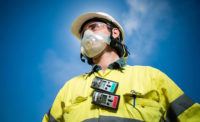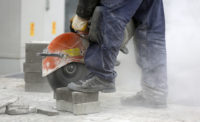Adopted: March 24, 2016.
Back story
The standards currently in place have been in development by OSHA since the late 1990s and represent the first regulatory update on silica exposure in 45 years.
The dangers of occupational exposure to silica have been known since ancient Greece, but gained considerable prominence in the U.S. in the 1930s, when a West Virginia hydroelectric project that involved workers drilling a tunnel through silica-laden rock resulted in an estimated 700 worker deaths.
In 1937, Secretary of Labor Frances Perkins declared war on silicosis, toured mines, convened national conferences on the problem, and issued a film entitled, “Stop Silicosis,” but it would be decades before OSHA and the Mine Safety and Health Administration (MSHA) adopted rules limiting silica dust exposures.
Despite the 1996 regulation, silicosis continued to claim the lives of workers – approximately 250 a year – and disable countless others. Work began on a comprehensive standard for construction and one for general industry and maritime that establish a new 8-hour time-weighted average permissible exposure limit and include provisions for product substitution, engineering controls, respiratory protection, and medical screening and surveillance.
Enforcement for the rule specific to the construction industry was originally scheduled to begin on June 23, 2017 but objections by the industry led to OSHA announcing a 90-day delay to allow it to conduct additional outreach and provide educational materials and guidance to employers.
Former OSHA Assistant Secretary David Michaels said the delay would be “paid by workers, in hundreds of preventable cases if cancer, destroyed lungs, and shortened lives” and that it would put employers who’d already instituted exposure measure at a competitive disadvantage to those who were delaying taking the steps necessary to comply with the standard.
Scope
The standard applies to all occupational exposures to respirable crystalline silica, except where employee exposure will remain below 25 μg/m3 as an 8-hour TWA under any foreseeable conditions and those occurring during agricultural operations covered under 29 CFR part 1928 and and exposures that result from the processing of sorptive clays.
Key hazards
Crystalline silica, a common mineral found in the earth's crust, is found in sand, stone, concrete, and mortar. It is also used to make products such as glass, pottery, ceramics, bricks, and artificial stone.
Respirable crystalline silica – very small particles at least 100 times smaller than the ordinary found on beaches and playgrounds – is created by cutting, sawing, grinding, drilling, and crushing stone, rock, concrete, brick, block, and mortar. Activities such as abrasive blasting with sand; sawing brick or concrete; sanding or drilling into concrete walls; grinding mortar; manufacturing brick, concrete blocks, stone countertops, or ceramic products; and cutting or crushing stone result in worker exposures to respirable crystalline silica dust. Industrial sand used in certain operations, such as foundry work and hydraulic fracturing (fracking), is also a source of respirable crystalline silica exposure.
About 2.3 million people in the U.S. are exposed to silica at work. Workers who inhale these very small crystalline silica particles are at increased risk of developing serious silica-related diseases, including silicosis, an incurable lung disease that can lead to disability and death; lung cancer; chronic obstructive pulmonary disease (COPD); and kidney disease.
Although there is no cure for silicosis, it is 100 percent preventable if employers, workers, and health professionals work together to reduce exposures.
An alert issued by the National Institute for Occupational Safety and Health (NIOSH) in 1992, Preventing Silicosis and Death in Rock Drillers1, highlights the severity of the disease. The Alert describes 23 cases of silicosis from exposure to crystalline silica during rock drilling. Of the 23 workers mentioned in the report, two had already died from silicosis at the time the alert was issued, and the remaining 21 were considered likely to eventually die from silicosis or its complications.
Key provisions
Employers must ensure that their employees’ exposures to respirable crystalline silica do not exceed the permissible exposure limit (PEL), which is 50 µg/m3 as an 8-hour TWA. This means that over the course of any 8-hour work shift, exposures can fluctuate, but the average exposure to respirable crystalline silica cannot exceed 50 μg/m3.
An employer has two options for limiting employee exposure to respirable crystalline silica: specified exposure control methods; or alternative exposure control methods.
Employers who follow alternative exposure control methods must: determine the levels of respirable crystalline silica that employees are exposed to; limit employee exposures to a PEL of 50 micrograms per cubic meter of air (50 μg/m3) as an 8-hour time-weighted average (TWA); use engineering and work practice controls, to the extent feasible, to limit employee exposures to the PEL, and supplement the controls with respiratory protection when necessary and keep records of employee exposure to respirable crystalline silica.
The standard also requires employers to establish and implement a written exposure control plan, including designating a competent person; offer medical exams to employees who will be required to wear a respirator under the standard for 30 or more days a year; communicate hazards and train employees; and keep records of medical examinations.
Benefits of the standard
The agency estimated that it will save over 600 lives and prevent more than 900 new cases of silicosis each year and provide net benefits of about $7.7 billion, annually.
Enforcement case study
An example of how and where silica exposure can occur can be found in a recent enforcement case in which OSHA cited U-Haul Company of New York & Vermont, doing business as U-Haul Moving & Storage at Larkin District, for exposing its employees to both crystalline silica and asbestos while performing renovation work at its storage facility in Buffalo.
OSHA inspectors found that the U-Haul dealer did not monitor the work area to determine if the two dangerous substances were present. It also failed to provide employees with respiratory protection, protective clothing, and training on asbestos and silica hazards. Additionally, the company did not properly dispose of asbestos-containing materials; have a competent person oversee renovation work; and provide a decontamination room.
“Employers must monitor the work area for the presence of these highly hazardous substances, and put in place effective controls to protect employees from exposure,” said Michael Scime, OSHA Buffalo Area Office Director.
The company faces $108,095 in proposed fines.
In the first six months after the standard took effect, OSHA and state plans issued 116 alleged silica violations to companies in the U.S. Many silica hazard citations are grouped with other jobsite safety violations.2
Compliance assistance
A number of resources that are available for employers seeking compliance assistance are industry-specific. There are separate “Small Entity Compliance Guides” for both construction and general industry and maritime. Construction companies can find a great deal of information in OSHA’s “FAQs for the Construction Industry,” “Fact Sheets for Construction” and a video entitled “Controlling Silica Dust in Construction.” A Powerpoint presentation, “Sample Training Powerpoint for Construction,” will enable the user to share the information with colleagues.
A video, “Protecting Workers from Silica Hazards in the Workplace,” offers general information.
For help in determining exposure levels, OSHA offers a Technical Manual (TED 01-00-015) that includes sampling information for crystalline silica. The Cyclone Leak Test Procedure webpage describes a method of leak testing cyclone sampler assemblies used for respirable sampling of silica







